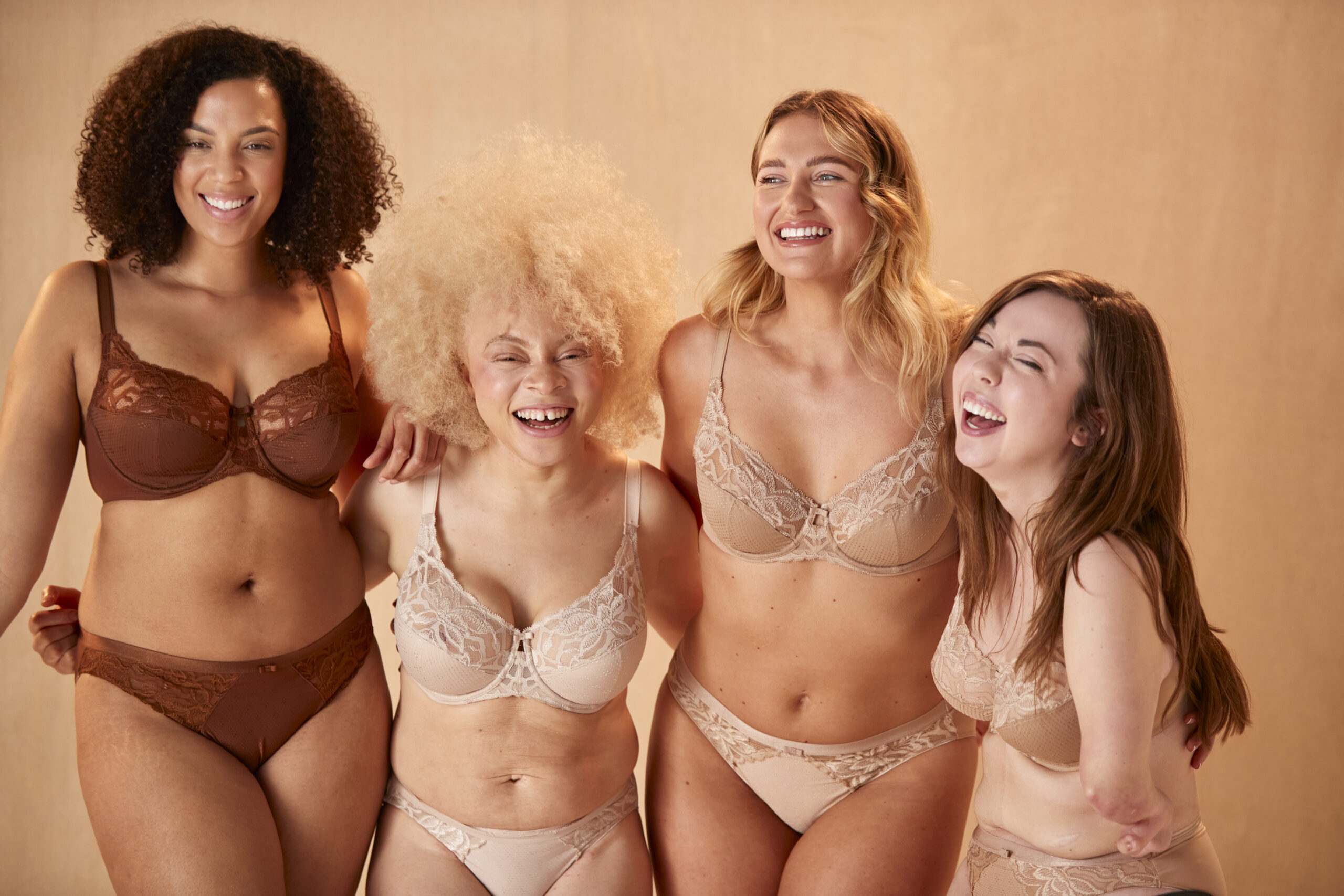Lingerie is a popular trend in the fashion business. Diversifying models and women’s need to feel comfortable and confident in all situations are inspiring more lingerie designers to start their brands. Starting a lingerie line can be a promising business opportunity, even for individuals who lack experience. It takes a manufacturer, enthusiasm, and energy to start a lingerie business!
Choose the lingerie you want to sell, focusing on the types of women’s lingerie and material. Lingerie includes a variety of items, ranging from ordinary bras and panties to more provocative pieces. You must also choose a name and develop a brand for your company, create a website, and utilize social media. Start your lingerie business by using our guide on 19 types of lingerie for women!
19 Different Styles of Lingerie and Their Properties
Deciding which of the many lingerie types is best for you can be overwhelming. Let’s examine the top 19 different lingerie types, which every woman ought to own. With these essential pieces, you may expand your collection and be ready to accommodate a variety of moods, events, and personal tastes.
Bra
For the best support, you need an everyday bra.
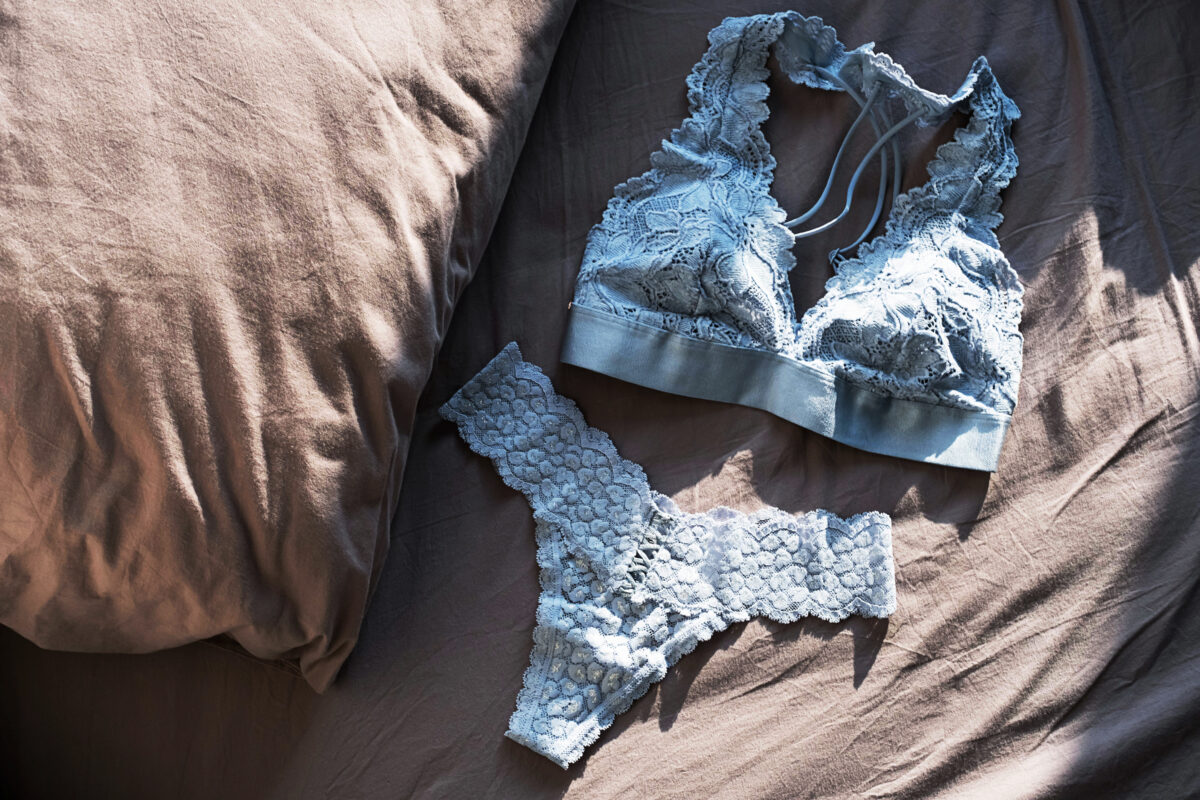
A bra serves a practical and stylish purpose by primarily covering a woman’s chest. Bras, the designers of the upper body, provide support and shape in various ways. There are several alternatives available, ranging from cordless models that prioritize comfort to push-up bras that enhance the bust. Whether it’s for a high-impact workout or a plunging neckline, your body type and the particular requirements of your ensemble can help you choose the ideal bra.
Bralette
A loose-fitting bralette is stylish but comfortable.
A bralette provides a more relaxed method of chest support because it does not have the rigid underwire found in standard bras. These items prioritize comfort without compromising design, frequently showcasing delicate lace or breathable cotton. Brands like Savage X Fenty have helped them gain a lot of popularity recently. Whether it’s a strappy design for a boho-chic style or a padded choice for a bit more support, bralettes provide a laid-back alternative in the lingerie scene. They’re ideal for days when you want to look stylish but feel free.
Bustier
Wear a bustier top to transition from the club to the bedroom.
A bustier is a form-fitting item of clothing that tightens the waist and raises the bust; it frequently doubles as outerwear. This multipurpose item is the chameleon of the lingerie industry; it looks lovely under a blazer or as the focal point of an outfit for a night out. Each of the many material options—from exquisite lace to structured satin—offers a unique degree of support and visual appeal. A bustier can adapt to different types of lingerie, from classic pin-ups to modern edgy appearances.
Corset
Wearing a corset instantly makes you look like a queen.
A garment with both historical and contemporary significance, corsets are made to constrict and contour the waist. Today’s corsets, which were once a mainstay of Victorian fashion, come in various styles, including fashion corsets and waist trainers. They provide a regal appearance by defining the waist and influencing posture. Each material has a distinct function, whether it’s demanding waist training or just creating a stylish statement. Materials range from flexible mesh to durable leather.
Camisole
Think of a camisole as the foundation of your ensemble.
A camisole is a type of sleeveless shirt that is frequently strap-based and can be worn as both outerwear and lingerie. These simple pieces are perfect for layering over a tight turtleneck or under a sheer blouse. Fabrics that provide subtle details to your ensemble range from delicate lace to smooth satin. Camisoles are a wardrobe must since they can be worn up or down, going from daytime casual to evening sophistication.
Panty
It’s always comfortable to use a panty.
Because they provide comfort and coverage, panties serve as the foundation layer for lower-body clothing. They are available in various styles, ranging from the cheeky charm of bikini cuts to the complete embrace of briefs. With alternatives like breathable cotton for everyday use and lace for special occasions, material is an important consideration. Pants are a personal statement in any wardrobe since each style and fabric gives a distinctive combination of comfort and style.
Thong
When wearing a thong, less is more.
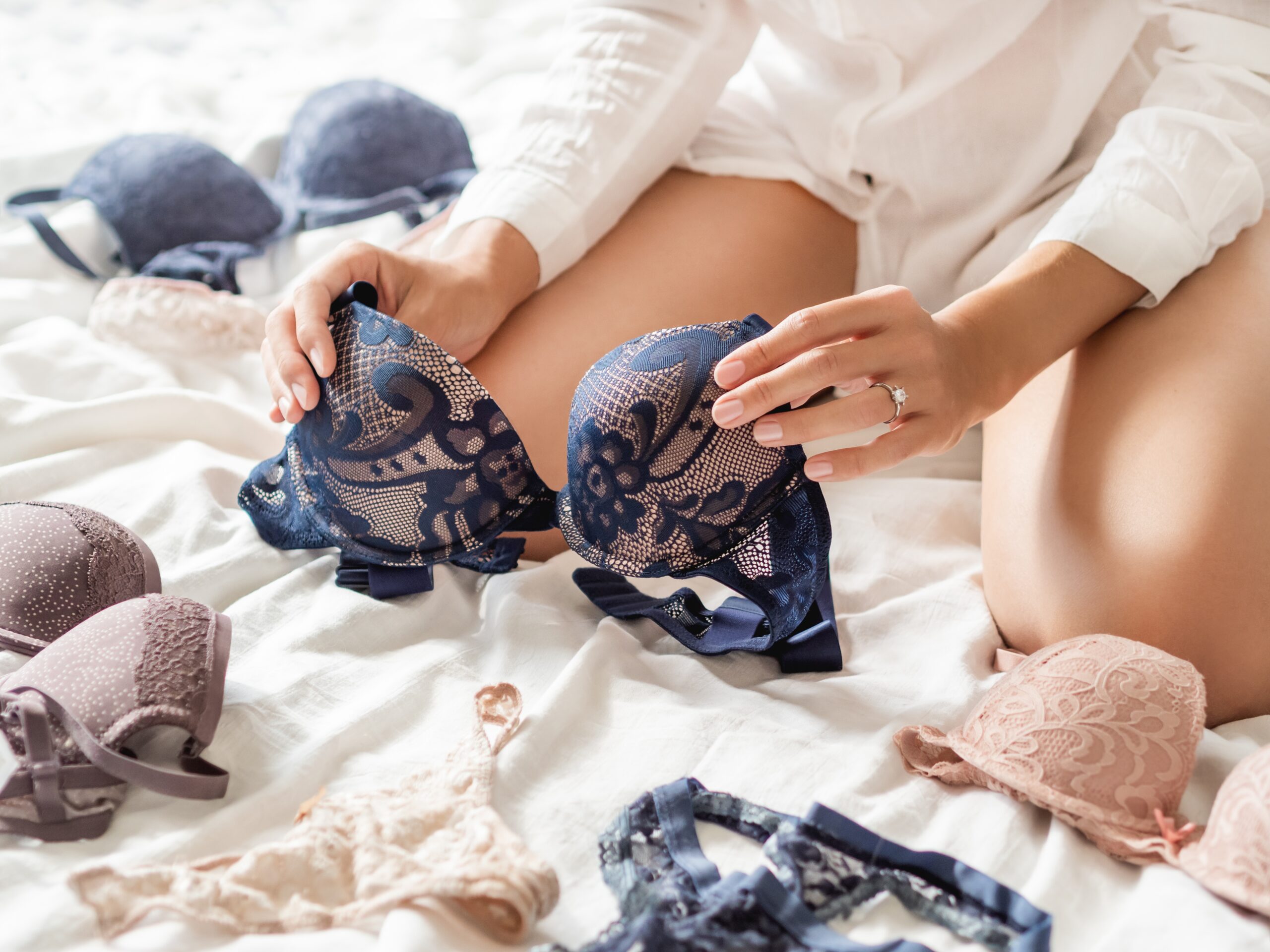
A thong is a simple form of underwear with less covering than regular panties that is intended to hide panty lines. With variants like G-strings and V-strings, thongs have established a distinct market in the lingerie industry. They provide a smooth effect and are the preferred choice for fitting dresses and tailored pants. Beyond practicality, thongs can add a sense of boldness, a subtle hint to bold personal style choices.
Bikini
Wear a cotton brief to stay at ease.
Bikini-style lingerie, which sits low on the hips and offers moderate coverage, complements full-coverage panties and minimum thongs. Every type of fabric for a bikini is intended to accentuate body shape and provide a beautiful silhouette. Bikinis provide a flexible choice for many moods and situations, whether you’re looking for a ruched back for a fun touch or a high-cut leg for elongation.
G-String
A G-string won’t display any lines.
With the least amount of coverage among panties, a G-string is an incredibly minimalist undergarment. This item, which is frequently selected because of its near-invisibility under clothing, is all about comfort and sensuality. Variations can include different fabrics like lace or silk, each providing its touch of charm. G-strings are a popular option for form-fitting clothing because they are not only exposing but also have the benefit of not having obvious panty lines.
Boyshort
Boyshorts are perfect for casually relaxing around the house.
Boyshorts are a type of pant that has a sporty look and complete coverage around the hips and buttocks. Although they are designed for women, they look like men’s briefs. The comfort kings of underwear, boyshorts are frequently composed of breathable, soft materials like modal or cotton.
Hosiery
With the variety of hosiery options, flaunt your legs.
Various leg coverings, such as tights and stockings, that go well with lingerie or outerwear are referred to as hosiery. These items may give any ensemble a touch of whimsy or refinement. Materials range from translucent nylon to opaque wool, each having a particular function: elegance or warmth. Hosiery is a flexible addition to any wardrobe since it may round off a well-chosen lingerie set or give flair to a basic outfit.
Garter Belts
Garter Belt Types: Formal garter belt with a lingerie channel classic design.
A garter belt, worn around the waist, has two functions: it keeps stockings in place and gives your lingerie ensemble a touch of sex. To hold stockings firmly in place, these belts frequently have adjustable straps that hang down and latch onto them. Materials can range from sumptuous silk to exquisite lace, each bringing its own visual flair. Garter belts are a flexible accessory that enhances both utility and style because they can be used with various apparel, including panties and corsets.
Teddy
For nighttime, a lacy teddy bear is always a timeless option.
A teddy is a one-piece garment that combines panty and camisole qualities to accentuate body curves. Each type offers a distinct look, ranging from the elegance of lace to the smooth feel of satin. Teddies offer a comprehensive selection of intimate statement pieces, catering to both bold plunges and backless styles.
Bodysuit
There are countless options when it comes to bodysuit styling.
A bodysuit is a form-fitting one-piece that covers the torso and crotch and can be worn as both stylish outerwear and lingerie. Bodysuits are available in a wide variety of styles, ranging from edgy lace-up patterns to tempting sheer materials. They can be worn alone in a dance class or as a foundation layer underneath your pants.
Chemise
A silk chemise adds opulence to your wardrobe.
A delicate, frequently short nightgown that may be worn for both intimate and casual occasions is called a chemise. These items, which range in material from silk to lace, give your nightly routine a hint of luxury. It can be dressed in various ways, including traditional black and red.
Babydoll
One way to add some excitement to your lingerie is to wear a babydoll.
A babydoll, which is typically constructed of light fabrics and has a short, loose-fitting skirt, is intended for both romance and play. It was first made popular in the 1950s and is still in style now. Babydolls are perfect for showing off a more whimsical side because of the ethereal texture of fabrics like silk and chiffon.
Slip
Slips are pieces that you can layer in your drawer of intimates.
Slips, which act as base clothing for outerwear, are made to be more comfortable and not cling. They give varying degrees of coverage and come in numerous varieties, such as half slips for skirts and complete slips for dresses. Slippers guarantee that you feel comfortable and that your ensemble looks its best.
Negligee
When you wear a sheer negligee, you’ll be the center of attention.
A negligee is a sheer, frequently short nightgown that emphasizes seduction and sensuality. Usually composed of opulent materials like silk, satin, or delicate lace, these garments frequently have elaborate embellishments like beadwork or embroidery. Instead of covering the body, negligees are made to skim it. They are the pinnacle of romantic evening dress, ideal for a wedding or to elevate any evening. They are ideal for private evenings since they provide enough coverage to pique interest.
Robe
When you need to cover up, a silk robe is the ideal finishing touch.
When it comes to lingerie, a robe is an opulent outer garment that lends a sense of luxury and mystery. These robes are designed to match the lingerie underneath and are frequently composed of sheer or silky materials like satin or lace. They might be long and flowing, trailing behind you like a whisper of grace, or they can be short, barely touching the thighs.
What Are The Most Common Fabrics Used In Lingerie?
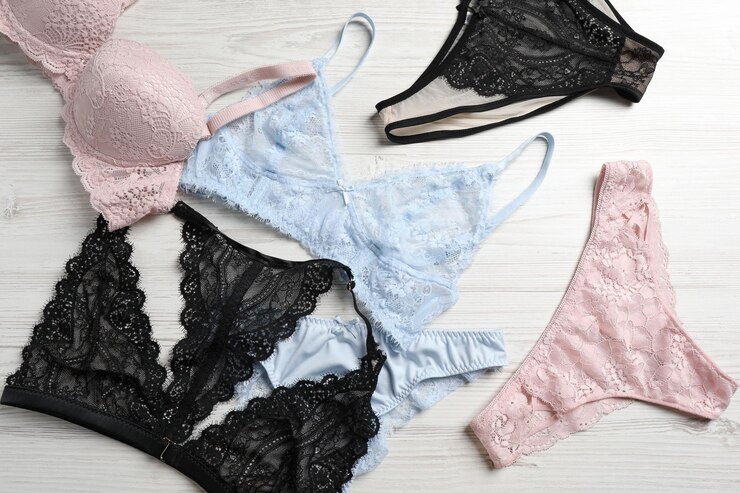
Fabrics created from hemp, cotton, bamboo, or wool differ from those made from nylon or spandex. The most popular fibers used to make underwear are:
Silk
Silk, made from silkworm cocoons, has been used for lingerie fabrics for generations. Its glittering appearance, smooth texture, and excellent dye absorption make it ideal for elegant lingerie. Silk is hypoallergenic and moisture-wicking, making it suitable for intimate clothing.
Pros
- Elegant and luxurious appearance
- Comfortable to wear.
- A strong, durable fiber
- Skin-friendly and hypoallergenic
- Breathable, moisture-wicking, temperature-regulating
- Excellent dye absorption for bright colors
Cons
- Costlier textiles
- Special care: hand-wash or dry-clean.
- Easily wrinkled
- This material is easily destroyed by perspiration, chemicals, or sunlight.
- Limited stretch and elasticity
- No structure or support
Cotton
Cotton is a natural material used in textiles for millennia. Its softness, strength, and absorbency make it a favorite lingerie fabric. Cotton’s capacity to breathe and wick moisture is its biggest asset in underwear.
Pros
- Comfortable, breathable, and soft for daily wear
- Strong and sturdy
- Highly absorbent and moisture-wicking
- Printable with many patterns and designs
- Comparatively cheap to silk
Cons
- Less luscious than silk
- Lack of structure or support
- Can shrink or deform
Spandex/Lycra
Lycra, or spandex, is a stretchy, durable material used in lingerie. For flexibility, support, and body shape customization, it’s commonly combined with other fibers. Spandex is utilized in shapewear and sports bras because of its compression and support characteristics.
Pros
- Excellent stretch and recovery for a precise fit
- Great compression and support
- Ventilated and moisture-wicking
- Compatible with knit and woven fabrics
- Ideal for shapewear and activewear
Cons
- Could cost more than other fibers
- Over time, they may lose flexibility.
- Pilling- and snagging-prone
Linen
Lingerie has long employed linen, a versatile and resilient textile. The flax plant fibers give it a natural, earthy look and feel. Linen, which isn’t popular for lingerie, is perfect for loungewear in warm and humid conditions due to its breathability.
Pros
- Ventilated and wicking
- Hypoallergenic/antibacterial
- Long-lasting and durable
- Naturally renewable, eco-friendly fabric
Cons
- Wrinkle-prone
- Washing may shrink or stretch.
- Hard to touch
- Limited prints and colors
- Unsuitable for compression, shaping, or support
Bamboo
Lingerie fabrics made from bamboo are sustainable. Made from bamboo grass pulp, it’s soft and airy. Bamboo is a renewable source, yet some bamboo fabrics are made with chemicals.
Pros
- Natural, soft, breathable
- Hypoallergenic and moisture-wicking
- Available in various textures and weights
Cons
- Not all bamboo fabrics are eco-friendly.
- Colors and prints are limited.
- Poor support and compression
Nylon
Although not the most attractive, nylon is a robust, elastic textile that has been used in women’s underwear for decades. It’s durable and simple to clean. Nylon is not breathable and can trap moisture against the skin.
Pros
- Lower cost than other textiles
- A strong, durable fiber
- Maintainable and easy
Cons
- Can appear cheap
- Non-breathable, moisture-trapping
- Not for hot or humid weather.
Rayon
Next is rayon, a semi-synthetic cellulose material that replaced silk. Lyocell, modal, and viscose are rayon fabrics.
Pros
- A versatile look
- An ideal summer lingerie fiber.
- High absorption
Cons
- Poor winter and cold weather suitability
- Poor support, form, and compression
Merino
Merino wool is a premium natural material known for its softness, resilience, and breathability. Its moisture-wicking and temperature-regulating characteristics make it popular for fitness and outdoor gear.
Pros
- Soft, breathable, and comfortable
- Warm, temperature-regulating
- Odor-resistant
- Fits activewear
Cons
- Expensive
- Needs careful care
- May irritate sensitive skin.
- Possible allergic reactions or itching
Hemp
As a robust material, hemp is ideal for long-lasting underwear. It has natural breathability and moisture-wicking properties to regulate body temperature and prevent odor.
Pros
- Durable, breathable
- Hypoallergenic
- Biodegradable and sustainable
Cons
- Limited supply and variety
- Might need particular care
- Wrinkles readily
Nylon Tricot
When examined, nylon tricot is a lightweight, durable zigzag fabric. It is popular as an outer and lining fabric because its smooth, shiny texture feels comfortable against the skin.
Pros
- Smooth, light, and soft
- Long-lasting and durable
- Fitted and stretchy
- Low-maintenance
Cons
- Less breathable than others
- Pilling-prone
- Less luxurious or glamorous
Stretch Lace
Stretch lace is delicate and used for lingerie embellishments. It fits snugly and is lightweight and stretchy. Stretch lace is used for bralettes, panties, and other lingerie that need a feminine, elastic touch.
Pros
- Feminine and delicate.
- Elastic, stretchy, and snug
- Ventilated and wicking
- Cheaper than other lace.
Cons
- Fragile and prone to tearing
- Synthetic materials are less eco-friendly.
Stretchy Velvet
Stretch velvet is one of the most sumptuous lingerie fabrics due to its soft texture and rich appearance. The sleek, elegant style and moderate flexibility make this velvet a popular choice.
Pros
- Elastic and elastic
- High-end appearance and feel
Cons
- Heavyweight
- Wrinkle-prone
Jersey
The single jersey can be constructed of rayon, bamboo, cotton, polyester, etc. Jersey fabrics stretch, drape, and fall well, making them ideal for babydolls and nightgowns.
Pros
- Drapes well.
- Lightweight and comfortable
Cons
- Regular wear and cleaning can deform it.
Light Double Knits
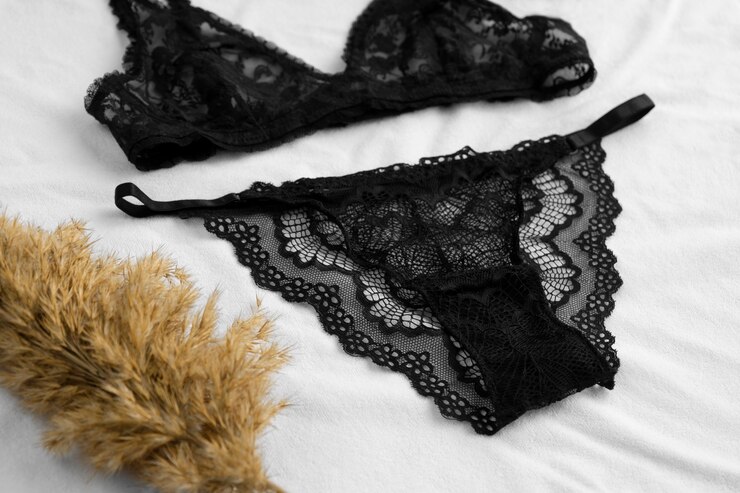
Thicker and more stable than single-knit textiles, lightweight double knits like cotton interlock can provide support and stability. Lingerie made with double-knit construction includes bras and shapewear.
Pros
- Versatile and durable
- Extra form and support
Cons
- Possibly too thick and hefty for some undergarments.
Simplex
Simplex is a silky fabric used for bra cups and other lingerie that needs support. This sturdy material is preferred for underwire bras since it supports and shapes well.
Pros
- Excellent for lingerie support and shape
- Ideal for underwire bras
Cons
- Not for all lingerie.
- Maybe overly weighty and sturdy
Mesh
Mesh is a lightweight, airy fabric used in lingerie for its sheerness. Mesh is commonly used for lingerie straps, panels, and trimmings.
Pros
- Increases transparency and sheerness.
- Lightweight and breathable
Cons
- Low strength and prone to ripping.
- Insufficient coverage
Power Net
Power net, used in shapewear and other body-hugging lingerie, is robust and durable. Its tight-knit structure supports and shapes the body well.
Pros
- Strong and sturdy
- Excellent shaping and support
- Ideal for shapewear and activewear
Cons
- Heavy and awkward to wear.
Microfiber
This delicate, lightweight fabric is utilized in lingerie because it breathes and wicks perspiration. This smooth fabric is popular for panties, bras, and other undergarments because it fits comfortably and seamlessly.
Pros
- Lightweight and soft
- Breathable and moisture-wicking
Cons
- Deforms over time
Lace
Lingerie uses lace for elegance and sensuality. Its elaborate patterns are made by weaving or embroidering threads. Lace can be manufactured from cotton, silk, or synthetic fibers.
Pros
- Ladies’ delicate fabric
- Can use various fibers
- Suitable for various lingerie items
Cons
- Feels unpleasant, scratchy, or irritating against skin Lacks strength, readily tearing or breaking
- Hard to clean and maintain
Satin
Satin, a silk-like fabric, gives lingerie a delicate feel. It’s shiny and constructed of silk, polyester, and nylon.
Pros
- A velvety, glossy appearance
- It is cheaper than silk, drapes well, and is durable.
Cons
- Shows sweat marks well
- Needs careful care
- Slimy and sticky
Organza
Lingerie uses organza for its sheerness and airiness. Its crisp texture and translucent look come from silk and synthetic fibers.
Pros
- Light and sheer
- It enhances texture and volume, making it perfect for layering.
Cons
- Stiff and scratchy
- Wrinkles easily; needs particular care
Chiffon
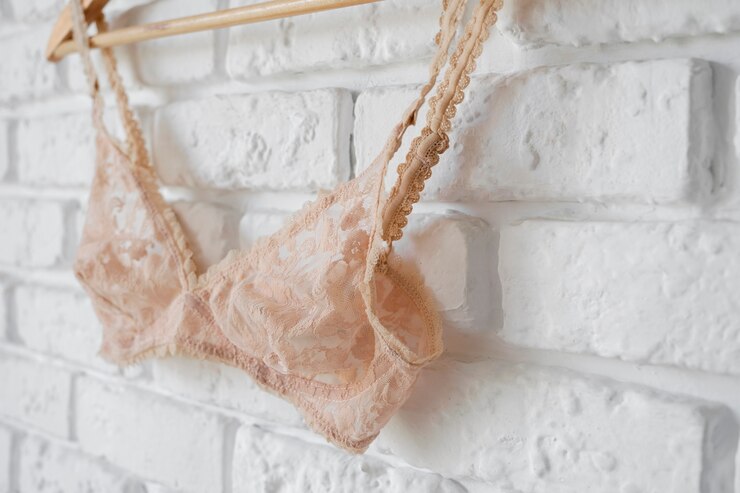
A sheer, light fabric manufactured from silk, polyester, or nylon, chiffon is next. Chiffon babydolls, chemises, and robes are available.
Pros
- Lightweight and sheer
- Excellent drapery, flow, and movement
- It adds volume to undergarments.
Cons
- Tear-prone and fragile
- Insufficient coverage
The Georgette
Georgette has a flowing, transparent, somewhat crinkled texture like chiffon. Georgette is used for chemises, camisoles, and robes like chiffon.
Pros
- Light and sheer
- This fabric adds texture and drapes wonderfully in lingerie.
Cons
- Tear-prone
- Too little coverage
Charmeuse
Lingerie uses this silky fabric for a lush, sensuous sensation. It’s one of the most expensive materials since it shines like liquid.
Pros
- It is smooth, silky, and long-lasting.
- Nice drapes and falls
Cons
- The fabric may stain readily.
- May need specific upkeep
China Silk
China silk, also referred to as habotai or lining cloth, is a cheap option for underwear. It is typically used as a lining fabric for lingerie because it is so delicate and thin.
Pros
- The material is breathable, lightweight, and soft.
- The fabric is extremely thin, making it ideal for layering.
Cons
- Unsuitable outerwear fabric
How Can Someone Start Their Lingerie Brand or Small Business?
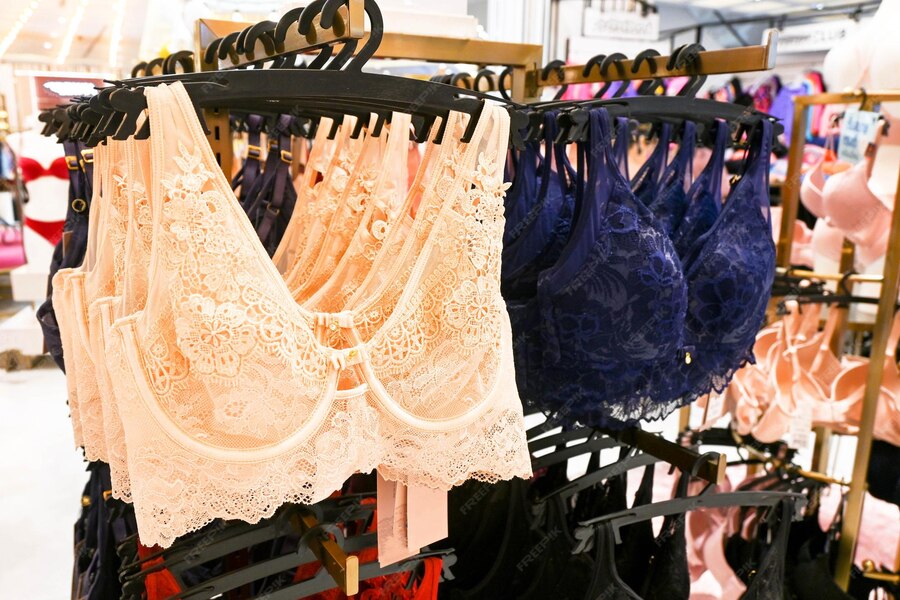
Starting a lingerie business requires preparation and hard work, regardless of the different kinds of lingerie you want to offer. To help you get off to a positive start and set yourself up for success, we’ve included an 8-step clothing line business plan in this section!
Step 1: Perform In-Depth Market Research on Lingerie
Do extensive market research before proceeding. Recognize different consumer segments, comprehend current trends, and carefully research your rivals. Examine the various popular types of lingerie, sizes, and fabrics. By meeting unmet requirements, identifying underserved areas can help you carve out your niche. Among the crucial elements of market research are
- Finding Trends: Keep tabs on consumer preferences and current fashion trends.
- Knowing Demographics: Determine your target market by taking into account variables like size, age, and preferred kinds of lingerie.
- Competitive Analysis: Analyze current brands to determine their advantages and disadvantages.
Step 2: Select Your Company Structure and Obtain the Necessary Licenses
Choosing the right business structure is essential for both financial and legal reasons. Among the most popular structures are
- A sole proprietorship is straightforward and easy to establish, but it entails personal liability.
- A limited liability company (LLC) strikes a balance between operational flexibility and liability protection.
- A corporation is ideal for larger companies that have complex organizational structures.
After deciding on your business structure, find out from the local government what licenses and permits are needed.
Step 3: Create the Identity of Your Brand
A key component of your lingerie business is branding. Create a brand identity and product range that appeals to your target market. Your brand should convey aesthetics and ideals by:
- Name: Pick a distinctive, memorable name that captures the spirit of your company.
- Design and Logo: Make an investment in superior design components and logos.
- Voice and Messaging: Make sure your voice is engaging and consistent on all platforms.
Step 4: Locate Trustworthy Vendors
Your suppliers have a major influence on the caliber of your items. How to find a garment manufacturer? Assuring consistency and simplifying inventory management are two benefits of working with reputable clothing manufacturers.
- Take into account elements like minimum order quantities, shipping schedules, and material quality.
Step 5: Set Up Your Office and Warehouse Space
The size of your business will determine how much space you require for offices and warehouses. Assess if you’ll require a physical space to operate your firm and store goods. Among the options are:
- Home offices are cost-effective solutions for startups and small enterprises.
- Larger stockpiles require a dedicated warehouse.
- Co-Workspace: Good for networking and teamwork while keeping setup costs down.
Step 6: Establish a Digital Presence
In today’s marketplace, having a strong internet presence is essential. Create a website that best represents your items and is both entertaining and easy to use. Use SEO best practices and e-commerce features to increase organic traffic. Among the tactics you can use to improve your online visibility are:
- Social media: Use sites like Facebook and Instagram to increase brand awareness and engagement.
- Content marketing: Write articles, videos, and social media posts about topics like self-love and body positivity.
- SEO: To raise your website’s search engine ranks, make sure your content and website are optimized for pertinent keywords.
Step 7: Create Your Physical Presence
If it fits with your business objectives, think about having a physical store. A physical store enhances consumer trust and improves the brand experience. It is important to choose a location that is both accessible and welcoming to your target audience.
Step 8: Advertising and Marketing
Using successful marketing techniques is essential for increasing brand recognition and attracting clients. Here are a few tactics to think about:
- Content marketing: Using blogs, videos, and social media posts, create a story around your business.
- SEO: To draw in natural traffic, make your website more visible on search engines.
- Paid Advertising: For focused campaigns, use platforms such as Google Ads or social network ads.
- Email marketing: Create an email list for campaigns and newsletters.
- Customer Loyalty Programs: Put in place initiatives that give loyal customers rewards.
- Collaborations: To increase reach, team up with influencers or businesses that complement one another.
What is the Startup Cost for Launching a Small Lingerie Brand?
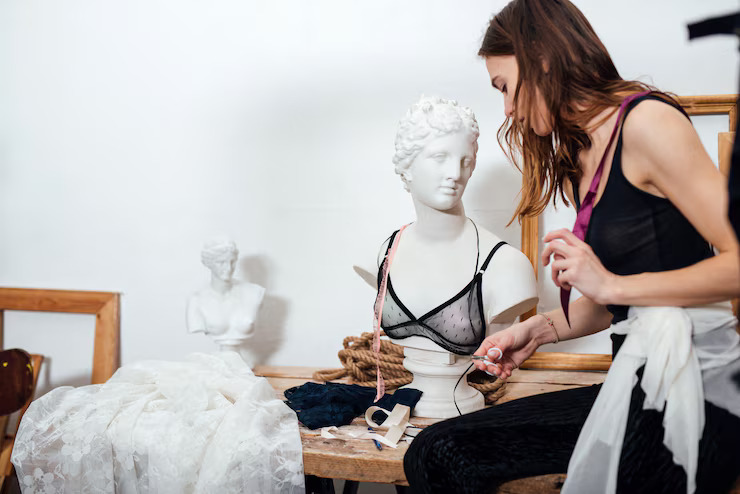
Gain insight into the main factors influencing the launch expenses of lingerie stores to improve your business strategy. Every element influences the total cost of operating a lingerie business and might direct your approach when opening a lingerie store. To create a solid financial plan for your intimate clothing store setup, keep reading.
- When starting a small lingerie store, the initial costs might mount up rapidly, but smart planning keeps prices in check. Negotiating bulk inventory savings with the lingerie manufacturer is one of the top priorities. According to actual data, bulk buying and efficient inventory management can cut expenses by 10% to 15%, providing a sizeable buffer for your luxury lingerie shop budget planning.
- Setting up a lingerie store requires careful consideration of both location and size. The cost of a store location varies greatly; in urban regions, it can cost up to $30 per square foot, whereas in suburban areas, it is less expensive. The size of the facility and retail leasing agreements have a direct impact on the cost of renovations and continuing operations.
- Another crucial component is the store concept. When compared to a typical department-style layout, a boutique arrangement, such as Intimate Elegance, necessitates a customized atmosphere and superior visual merchandising, which frequently results in greater shop renovation costs. This discrepancy has the potential to drastically alter the initial investment in a retail establishment.
- There are different cost consequences for new vs existing space. While adapting a current location may save initial expenses, it still requires compliance changes, such as retail licences and permits, and building up a new space can be costly due to the substantial customization requirements. Making this decision is crucial to managing your entire investment.
- Approximately two to five percent of your initial expenses will go on licenses and permits, which are essential. These expenses include retail compliance, business registration, and safety certificates, which guarantee that you adhere to industry standards and local zoning laws.
- A $1,000 to $5,000 initial investment may be needed for technology and systems like inventory management and point-of-sale systems. Using effective solutions for e-commerce lingerie businesses improves consumer satisfaction and streamlines operations.
Advice on Managing Your Budget
- Utilize long-term contracts and compare several locations to negotiate retail lease terms.
- To make cross-channel operations more efficient, spend money on intuitive inventory management software.
- Make use of social media and local influencers for economical marketing campaigns.
- Set aside at least 10% of the budget for unforeseen costs as a contingency measure.
Final Words
As you venture into the dynamic world of lingerie, remember that the key to success lies in thoughtful planning, inspired creativity, and meticulous execution. Choosing the right lingerie types, fabrics, and supplier sets the foundation for elegance, comfort, and confidence. From everyday essentials to statement pieces, each design choice shapes your brand’s identity. Are you a new entrepreneur considering how to start an apparel line? Working with a skilled clothing manufacturer like Affix Apparel guarantees the precise, high-quality, and efficient realization of your vision. With the right support, your lingerie line can emerge beautifully crafted and ready to enchant the market.

